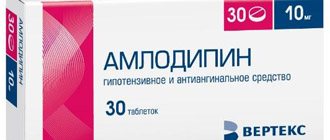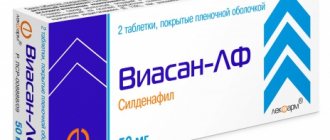Ibuprofen-Hemofarm (tablets)
The risk of side effects can be minimized if the drug is taken in a short course, at the minimum effective dose required to eliminate symptoms.
Elderly people experience an increased incidence of adverse reactions with NSAID use, especially gastrointestinal bleeding and perforation, in some cases fatal.
Side effects are predominantly dose-dependent.
The following adverse reactions were observed with short-term use of ibuprofen in doses not exceeding 1200 mg/day (6 tablets). When treating chronic conditions and with long-term use, other adverse reactions may occur.
The frequency of adverse reactions (ARs) listed below is listed according to the following classification: very common (≥ 10%), common (≥ 1% but < 10%), uncommon (≥ 0.1% but < 1%) , rare (≥ 0.01% but < 0.1%), very rare (< 0.01%), frequency unknown - frequency cannot be estimated from available data.
Blood and lymphatic system disorders
Very rare:
hematopoietic disorders (anemia, leukopenia, aplastic anemia, hemolytic anemia, thrombocytopenia, pancytopenia, agranulocytosis). The first symptoms of such disorders are fever, sore throat, superficial oral ulcers, flu-like symptoms, severe weakness, nosebleeds and subcutaneous hemorrhages, bleeding and bruising of unknown etiology.
Immune system disorders
Uncommon:
hypersensitivity reactions - nonspecific allergic reactions and anaphylactic reactions, reactions from the respiratory tract (bronchial asthma, including its exacerbation, bronchospasm, shortness of breath, dyspnea), skin reactions (itching, urticaria, purpura, Quincke's edema, exfoliative and bullous dermatoses, including toxic epidermal necrolysis (Lyell's syndrome), Stevens-Johnson syndrome, erythema multiforme), allergic rhinitis, eosinophilia.
Very rare:
severe hypersensitivity reactions, including swelling of the face, tongue and larynx, shortness of breath, tachycardia, arterial hypotension (anaphylaxis, Quincke's edema or severe anaphylactic shock).
Gastrointestinal disorders
Uncommon:
abdominal pain, nausea, dyspepsia (including heartburn, bloating).
Rare:
diarrhea, flatulence, constipation, vomiting.
Very rare:
peptic ulcer, perforation or gastrointestinal bleeding, melena, hematemesis, in some cases fatal, especially in elderly patients, ulcerative stomatitis, gastritis.
Frequency unknown:
exacerbation of colitis and Crohn's disease.
Disorders of the liver and biliary tract
Very rare:
liver dysfunction (especially with long-term use), increased activity of “liver” transaminases, hepatitis and jaundice.
Renal and urinary tract disorders
Very rare:
acute renal failure (compensated and decompensated), especially with long-term use, in combination with an increase in the concentration of urea in the blood plasma and the appearance of edema, hematuria and proteinuria, nephritic syndrome, nephrotic syndrome, papillary necrosis, interstitial nephritis, cystitis.
Nervous system disorders
Uncommon:
headache.
Very rare:
aseptic meningitis.
Cardiovascular disorders
Frequency unknown:
heart failure, peripheral edema, with long-term use there is an increased risk of thrombotic complications (for example, myocardial infarction), increased blood pressure.
Disorders of the respiratory system and mediastinal organs
Frequency unknown:
bronchial asthma, bronchospasm, shortness of breath.
Laboratory indicators
- hematocrit or hemoglobin (may decrease);
- bleeding time (may increase);
- plasma glucose concentration (may decrease);
- creatinine clearance (may decrease);
- plasma creatinine concentration (may increase);
- activity of “liver” transaminases (may increase).
If any of the side effects indicated in the instructions get worse, or you notice any other side effects not listed in the instructions, tell your doctor.
Ibuprofen-Hemofarm tablet film 400 mg pack cont cell/pack card x30
Trade name: Ibuprofen-Hemofarm International name: Ibuprofen
Release form: film-coated tablets 400 mg (blisters)
Ingredients: ibuprofen 400 mg
Pharmacological group: NSAID (non-steroidal anti-inflammatory drug)
Pharmacological group according to ATK: M01AE01 (Ibuprofen)
Pharmacological action: antiplatelet, antipyretic, NSAID, anti-inflammatory, analgesic,
Indications: Inflammatory and degenerative diseases of the musculoskeletal system: rheumatoid, juvenile chronic, psoriatic arthritis, osteochondrosis, neuralgic amyotrophy (Personage-Turner disease), arthritis with SLE (as part of complex therapy), gouty arthritis (in case of an acute attack of gout, fast-acting medications are preferred forms), ankylosing spondylitis (ankylosing spondylosis). Pain syndrome: myalgia, arthralgia, ossalgia, arthritis, sciatica, migraine, headache (including menstrual syndrome) and toothache, cancer, neuralgia, tendinitis, tendovaginitis, bursitis, neuralgic amyotrophy (Personage-Turner disease) , post-traumatic and postoperative pain syndrome, accompanied by inflammation. Algodismenorrhea, inflammatory process in the pelvis, incl. adnexitis, childbirth (as an analgesic and tocolytic agent). Feverish syndrome with “colds” and infectious diseases.
Dosage regimen: Inside, after meals. Adults: for osteoarthritis, psoriatic arthritis and ankylosing spondylitis - 400-600 mg 3-4 times a day. For rheumatoid arthritis - 800 mg 3 times a day, for soft tissue injuries, sprains - 1.6-2.4 g / day in several doses. For algodismenorrhea - 400 mg 3-4 times a day, for moderate pain syndrome - 1.2 g / day. For children over 12 years of age, the initial dose is 150-300 mg 3 times a day, the maximum dose is 1 g, then 100 mg 3 times a day, for juvenile rheumatoid arthritis - 30-40 mg/kg/day in several doses. To reduce body temperature 39.2 degrees C and above - 10 mg/kg/day, below 39.2 degrees C - 5 mg/kg/day. Oral suspension - 5-10 mg/kg 3 times a day: children aged 6-12 months (only as prescribed by a doctor) - an average of 50 mg 3-4 times a day, 1-3 years - 100 mg 3 times per day, 4-6 years - 150 mg 3 times a day, 7-9 years - 200 mg 3 times a day, 10-12 years - 300 mg 3 times a day. For febrile syndrome after immunization - 50 mg, if necessary, after 6 hours, repeat administration at the same dose, maximum daily dose - 100 mg.
Contraindications: Hypersensitivity, erosive and ulcerative diseases of the gastrointestinal tract (including peptic ulcer of the stomach and duodenum in the acute stage, ulcerative colitis, peptic ulcer, Crohn's disease - nonspecific ulcerative colitis), "aspirin" asthma, blood clotting disorders (including hemophilia, prolongation of bleeding time, bleeding tendency, hemorrhagic diathesis), pregnancy, lactation.
Side effects: From the digestive system: NSAID gastropathy (nausea, vomiting, abdominal pain, heartburn, loss of appetite, diarrhea, flatulence, pain and discomfort in the epigastric region), ulceration of the gastrointestinal mucosa (in some cases complicated by perforation and bleeding) , irritation, dryness of the oral mucosa or pain in the mouth, ulceration of the gum mucosa, aphthous stomatitis, pancreatitis, constipation, hepatitis. From the respiratory system: shortness of breath, bronchospasm. From the senses: hearing loss, ringing or noise in the ears, reversible toxic optic neuritis, blurred vision or diplopia, dryness and irritation of the eyes, swelling of the conjunctiva and eyelids (allergic origin), scotoma. From the nervous system: headache, dizziness, insomnia, anxiety, nervousness and irritability, psychomotor agitation, drowsiness, depression, confusion, hallucinations, rarely - aseptic meningitis (more often in patients with autoimmune diseases). From the cardiovascular system: development or worsening of heart failure, tachycardia, increased blood pressure. From the urinary system: acute renal failure, allergic nephritis, nephrotic syndrome (edema), polyuria, cystitis. Allergic reactions: skin rash (usually erythematous, urticaria), skin itching, angioedema, anaphylactoid reactions, anaphylactic shock, bronchospasm, fever, erythema multiforme exudative (including Stevens-Johnson syndrome), toxic epidermal necrolysis (Lyell's syndrome) , eosinophilia, allergic rhinitis. From the hematopoietic organs: anemia (including hemolytic, aplastic), thrombocytopenia and thrombocytopenic purpura, agranulocytosis, leukopenia. Other: increased sweating. The risk of developing ulcerations of the gastrointestinal mucosa, bleeding (gastrointestinal, gingival, uterine, hemorrhoidal), visual impairment (impaired color vision, scotoma, amblyopia) increases with long-term use in large doses. Overdose. Symptoms: abdominal pain, nausea, vomiting, lethargy, drowsiness, depression, headache, tinnitus, metabolic acidosis, coma, acute renal failure, decreased blood pressure, bradycardia, tachycardia, atrial fibrillation, respiratory arrest. Treatment: gastric lavage (only within an hour after administration), activated charcoal, alkaline drinking, forced diuresis, symptomatic therapy (correction of CBS, blood pressure).
Pharmacodynamics: NSAIDs have analgesic, antipyretic and anti-inflammatory effects due to non-selective blockade of COX1 and COX2 and have an inhibitory effect on Pg synthesis. The analgesic effect is most pronounced for inflammatory pain. Like all NSAIDs, ibuprofen exhibits antiplatelet activity.
Pharmacokinetics: Well absorbed from the gastrointestinal tract. Absorption is slightly reduced when taking the drug after meals. TCmax when taken on an empty stomach - 45 minutes, when taken after meals - 1.5-2.5 hours, in synovial fluid - 2-3 hours (where it creates higher concentrations than in plasma). 90% bound to plasma proteins. Subject to presystemic and postsystemic metabolism in the liver. After absorption, approximately 60% of the pharmacologically inactive R form of ibuprofen is slowly transformed into the active S form. The CYP2C9 isoenzyme takes part in the metabolism of the drug. It has two-phase elimination kinetics with T1/2 2-2.5 hours (for retard forms - up to 12 hours). It is excreted by the kidneys (no more than 1% unchanged) and, to a lesser extent, with bile.
Special instructions: During treatment, monitoring of the peripheral blood picture and the functional state of the liver and kidneys is necessary. When symptoms of gastropathy appear, careful monitoring is indicated, including esophagogastroduodenoscopy, a blood test to determine Hb, hematocrit, and a stool test for occult blood. To prevent the development of NSAID gastropathy, it is recommended to combine it with PgE drugs (misoprostol). If it is necessary to determine 17-ketosteroids, the drug should be discontinued 48 hours before the study. Patients should refrain from all activities that require increased attention, rapid mental and motor reactions. During the treatment period, ethanol intake is not recommended. Carefully. Cirrhosis of the liver with portal hypertension, hyperbilirubinemia, peptic ulcer of the stomach and duodenum (history), gastritis, enteritis, colitis, liver and/or renal failure, nephrotic syndrome, CHF, arterial hypertension, blood diseases of unknown etiology (leukopenia and anemia ), children's age (for tablet forms - up to 12 years, 6 months - for oral suspension). Children 6-12 months are prescribed only on the recommendation of a doctor.
Interaction: Inducers of microsomal oxidation (phenytoin, ethanol, barbiturates, rifampicin, phenylbutazone, tricyclic antidepressants) increase the production of hydroxylated active metabolites, increasing the risk of severe hepatotoxic reactions. Microsomal oxidation inhibitors reduce the risk of hepatotoxicity. Reduces the hypotensive activity of vasodilators (including BMCC and ACE inhibitors), natriuretic and diuretic activity - furosemide and hydrochlorothiazide. Reduces the effectiveness of uricosuric drugs, enhances the effect of indirect anticoagulants, antiplatelet agents, fibrinolytics (increasing the risk of hemorrhagic complications), ulcerogenic effect with bleeding of MCS and GCS, colchicine, estrogens, ethanol, enhances the effect of oral hypoglycemic drugs and insulin. Antacids and cholestyramine reduce the absorption of ibuprofen. Increases the blood concentration of digoxin, Li+ drugs and methotrexate. Caffeine enhances the analgesic effect. When administered simultaneously, ibuprofen reduces the anti-inflammatory and antiplatelet effects of ASA (an increase in the incidence of acute coronary insufficiency in patients receiving small doses of ASA as an antiplatelet agent is possible after starting ibuprofen). When prescribed with anticoagulant and thrombolytic drugs (alteplase, streptokinase, urokinase), the risk of bleeding simultaneously increases. Cefamandole, cefaperazone, cefotetan, valproic acid, plicamycin increase the incidence of hypoprothrombinemia. Myelotoxic drugs increase the manifestations of hematotoxicity of the drug. Cyclosporine and Au preparations enhance the effect of ibuprofen on Pg synthesis in the kidneys, which is manifested by increased nephrotoxicity. Ibuprofen increases the plasma concentration of cyclosporine and the likelihood of developing its hepatotoxic effects. Drugs that block tubular secretion reduce excretion and increase plasma concentrations of ibuprofen.
Dispensed from pharmacies: Dispensed by prescription.
Drug registration number: P No. 015343/02
Date of registration (re-registration) of the drug: December 30, 2003
Pharmacokinetics
Well absorbed when taken orally (absorption is slightly reduced when taken after meals). After absorption, about 60% of the pharmacologically inactive R-form is slowly transformed into the active S-form (biological activity is associated with the S-enantiomer). Cmax in blood plasma when taken on an empty stomach is achieved after 45 minutes, when taken after meals - after 1.5–2.5 hours, in synovial fluid, where a higher concentration is created than in blood plasma - 2–3 hours. Binding to blood proteins - 90%. Subject to presystemic and postsystemic metabolism in the liver. Slowly penetrates into the joint cavity and lingers in the synovial fluid. It is excreted by the kidneys (no more than 1% unchanged) and with bile (to a lesser extent). T1/2 - 2–2.5 hours (for retard forms - up to 12 hours). In elderly patients, pharmacokinetic parameters do not change.
Directions for use and doses
Inside, after eating, the effervescent tablet should be completely dissolved in a glass of water (the resulting solution is drunk immediately). The dose is prescribed individually so that the desired therapeutic effect is obtained using the lowest possible dose.
Adults and children over 12 years old. For acute pain - 200–400 mg every 4–6 hours; for fever - initial dose 200 mg every 4-6 hours, if necessary - 400 mg every 4-6 hours; for rheumatoid arthritis - 2.4–3.2 g/day in 4–6 divided doses. The maximum daily dose is 40 mg/kg.
Children from 6 months to 12 years. For fever - 5-10 mg/kg/day in 4-5 doses, treatment should not last more than 3 days without consulting a doctor; for juvenile rheumatoid arthritis, children weighing less than 20 kg - 400 mg / day in 4-5 doses, body weight 20-30 kg - 600 mg / day, body weight 30-40 kg - 800 mg / day, more than 40 kg - dosage as for adults.
Effervescent tablets are recommended for children over 6 years of age and adults.
Contraindications
Hypersensitivity, erosive and ulcerative diseases of the gastrointestinal tract (including peptic ulcers, Crohn's disease - ulcerative colitis), diseases of the optic nerve, scotoma, amblyopia, impaired color vision, hearing loss, pathology of the vestibular apparatus, "aspirin" asthma (provoked taking acetylsalicylic acid or other NSAIDs), heart failure, edema, arterial hypertension, blood clotting disorders (including hypocoagulation), hemophilia, leukopenia, hemorrhagic diathesis, glucose-6-phosphate dehydrogenase deficiency, pregnancy (III trimester).
Precautionary measures
During treatment, monitoring of the peripheral blood picture and the functional state of the liver and kidneys is necessary. When symptoms of gastropathy appear, careful monitoring is indicated, including esophagogastroduodenoscopy, a blood test to determine hemoglobin, hematocrit, and a stool test for occult blood. To prevent the development of NSAID gastropathy, it is recommended to combine it with drugs containing misoprostol. If it is necessary to determine 17-ketosteroids, the drug should be discontinued 48 hours before the study. Use with caution in case of hyperbilirubinemia, cirrhosis of the liver with portal hypertension, peptic ulcer of the stomach and duodenum (history), gastritis, enteritis, colitis, liver and/or renal failure, nephrotic syndrome, blood diseases of unknown etiology, pregnancy, breastfeeding, children under 12 years old. Use with caution while working for vehicle drivers and people whose profession involves increased concentration. During the treatment period, ethanol intake is not recommended.
Nosological classification (ICD-10)
- G54.1 Lesions of the lumbosacral plexus
- G54.5 Neuralgic amyotrophy
- J00 Acute nasopharyngitis [runny nose]
- J01 Acute sinusitis
- J02.9 Acute pharyngitis, unspecified
- J03.9 Acute tonsillitis, unspecified (angina agranulocytic)
- J04.0 Acute laryngitis
- K08.8.0* Toothache
- M06.9 Rheumatoid arthritis, unspecified
- M10 Gout
- M15-M19 Arthrosis
- M45 Ankylosing spondylitis
- M47 Spondylosis
- M65 Synovitis and tenosynovitis
- M71 Other bursopathies
- M77.9 Enthesopathy, unspecified
- M79.0 Rheumatism, unspecified
- M79.1 Myalgia
- M79.2 Neuralgia and neuritis, unspecified
- M79.3 Panniculitis, unspecified
- N70 Salpingitis and oophoritis
- N94.6 Dysmenorrhea, unspecified
- R50 Fever of unknown origin
- R51 Headache
- R52.0 Acute pain
- R52.2 Other persistent pain
- T14.0 Superficial injury to unspecified body area
- T14.3 Dislocation, sprain and damage to the capsular-ligamentous apparatus of a joint of an unspecified area of the body
Interaction
Inducers of microsomal oxidation (ethanol, barbiturates, rifampicin, tricyclic antidepressants) increase the production of hydroxylated active metabolites, increasing the risk of severe hepatotoxic reactions. Inhibitors of microsomal oxidation reduce the risk of hepatotoxicity. Reduces the hypotensive activity of vasodilators, incl. blockers of slow calcium channels and ACE inhibitors), natriuretic and diuretic activity of furosemide and hypothiazide, the effectiveness of uricosuric drugs. Strengthens the effect of antiplatelet agents, fibrinolytics (increasing the risk of hemorrhagic complications), oral hypoglycemic agents and insulin. When interacting with mineral and glucocorticosteroids, colchicine, estrogen, ethanol, an ulcerogenic effect may occur with the development of bleeding. Antacids and cholestyramine reduce the absorption of ibuprofen. Increases the concentration of digoxin, phenytoin, methotrexate, lithium in the blood plasma. Caffeine enhances the analgesic effect. When administered simultaneously with acetylsalicylic acid, it reduces the overall anti-inflammatory effect. When prescribed with thrombolytic agents (alteplase, streptokinase, urokinase), the risk of bleeding simultaneously increases. Cefamandole, cefaperazone, cefotetan, valproic acid, plicamycin increase the incidence of hypoprothrombinemia. Cyclosporine and gold preparations enhance the effect of ibuprofen on the synthesis of PG in the kidneys and increase nephrotoxicity. Ibuprofen increases the plasma concentration of cyclosporine and the likelihood of developing its hepatotoxic effects. Drugs that block tubular secretion reduce excretion and increase plasma concentrations of ibuprofen. When used simultaneously with potassium-sparing diuretics, the risk of developing hyperkalemia increases, and with other NSAIDs - the risk of developing side effects from the gastrointestinal tract.
Indications for the drug Ibuprofen-Hemofarm
Rheumatoid arthritis, osteoarthritis, articular syndrome with exacerbation of gout, psoriatic arthritis, ankylosing spondylitis (ankylosing spondylitis), spondylosis; neuralgia, myalgia, tendinitis, bursitis, tendovaginitis, neural amyotrophy of Charcot-Marie-Tooth (peroneal muscular atrophy), sprain of the ligamentous apparatus, hematomas, radiculitis, traumatic damage to soft tissues and the musculoskeletal system; febrile states of various origins (including after immunization), influenza and acute respiratory viral infections.
As an adjuvant for infectious and inflammatory diseases of the ENT organs (tonsillitis, pharyngitis, laryngitis, sinusitis, rhinitis), inflammatory processes in the pelvis, adnexitis, algodismenorrhea, postoperative pain syndrome, headache and toothache, panniculitis.
Composition and release form
| Film-coated tablets | 1 table |
| ibuprofen | 400 mg |
| excipients: MCC; sodium carboxymethyl starch; anhydrous colloidal silicon dioxide; stearic acid; Eudragit L; talc; titanium dioxide; polysorbate 80 |
10 pcs in blister; in a cardboard pack there are 1, 2, 3 or 5 blisters.
| Tablets for making effervescent drink | 1 effervescent tablet |
| ibuprofen (as lysinate) | 200 mg |
| excipients: sodium carbonate; sodium dihydrogen citrate; sodium bicarbonate; povidone K25; sodium saccharin; aspartame; xylitol; lemon flavor; silicone emulsion |
plastic tube 10 or 20 pcs.; in a cardboard pack 1 tube.



